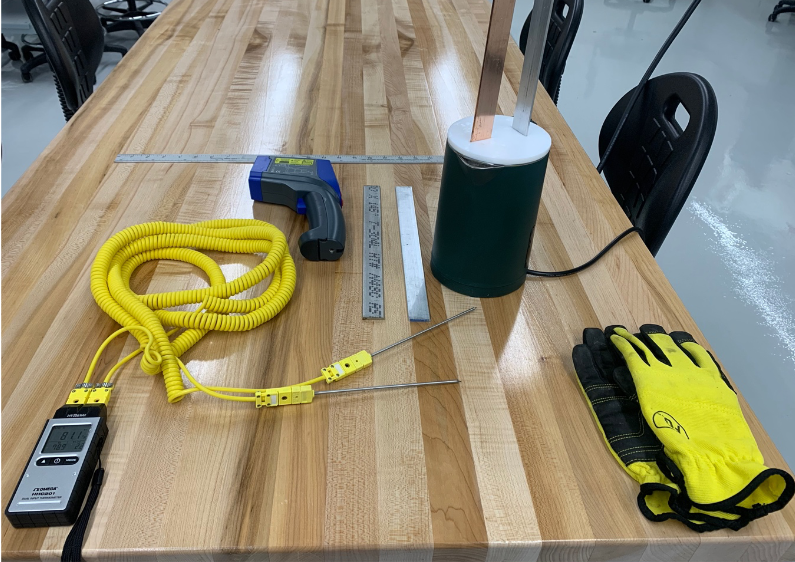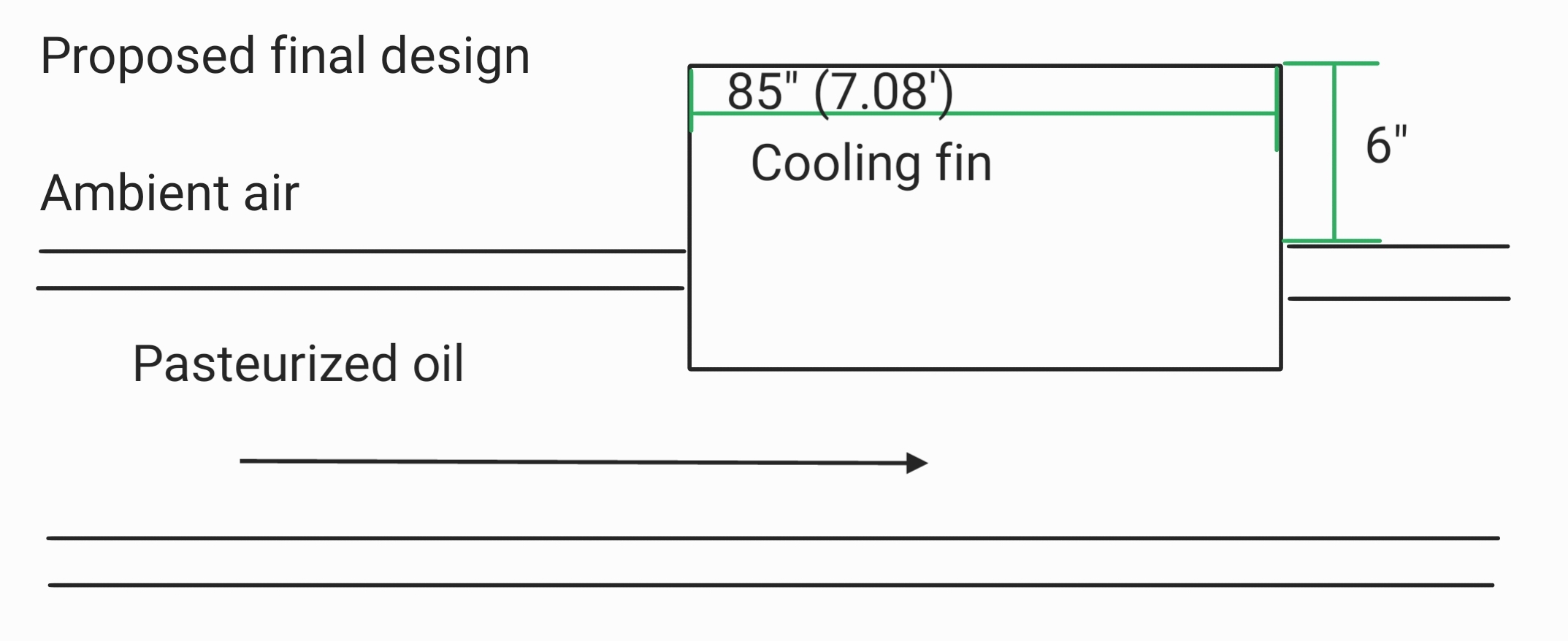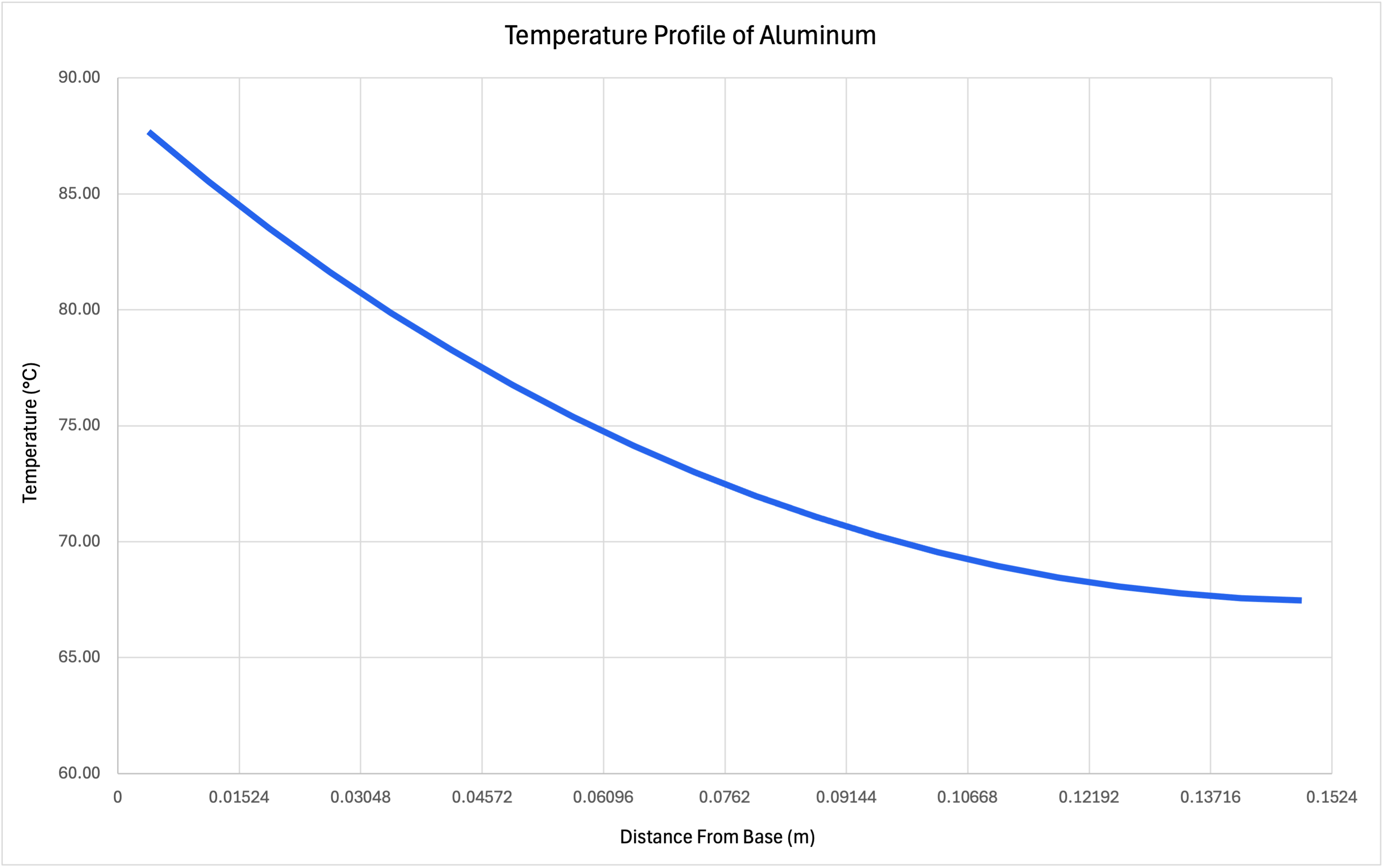Cooling Optimization Study
This project explores a simple fin design for an insulated pipe that delivers oil 1°C too hot.
Group
Tue-4-2
Members
Dominique Taylor
Cameron Barton
Ever Muniz
Date
August 26 2025 - September 16 2025
Problem Statement & Objectives
Engineering challenge analysis and optimization requirements for the Frantoio Franci olive oil facility.
The Challenge
The Frantoio Franci has an olive oil processing facility that requires a cost-effective solution to reduce their hot olive oil temperature by 1°C leading up to the bottling process. The current system lacks sufficient heat dissipation capacity, creating a bottleneck in production efficiency.
Current Operating Conditions
Constraints & Requirements
Cost Optimization
Minimize material and installation costs while achieving temperature reduction
Space Limitations
Fin must be installed above existing insulation with 6-inch clearance
Performance Target
Achieve exactly 1°C temperature reduction through enhanced convection
Material Selection
Evaluate aluminum and copper options with different surface treatments
Material Optimization
Determine the most cost-effective fin material and required length to achieve the target 1°C temperature reduction through systematic experimental analysis.
Success Criteria
- • Achieve 1°C temperature reduction
- • Minimize total project cost
- • Validate theoretical predictions
Experimental Validation
Validate theoretical heat transfer calculations through controlled laboratory experiments and compare predicted versus actual fin performance. Determine the ability of each fin material through testing. Experimental data will lead to theoretical application providing a solid basis for cost-benefit analysis.
Validation Methods
- • Temperature profile measurements
- • Heat transfer rate calculations
- • Fin/cost efficiency analysis
Design Recommendation
Provide quality engineering recommendations for fin material and dimensions based on comprehensive cost-benefit analysis.
Deliverables
- • Optimal material selection
- • Required fin dimensions
- • Implementation cost analysis
Approach to the Problem
Theoretical framework and methods used to address the heat dissipation challenge.
Theoretical Framework
Heat Transfer Equation
q = h·A·(T₂-T₁) + σ·e·A·(T₂⁴-T₁⁴)
Heat Dissipation Required
q = ṁ·cₚ·ΔT
Energy Balance
h·A·ΔT+σ·e·A·(T₂⁴-T₁⁴) = ṁ·cₚ·ΔT
Common Legend
Material Selection Strategy
1. Determining Materials to Use
We picked 2 commonly used and easily accessible materials for heat dissipation fins: copper and aluminum. After which we decided to paint an extra copper fin black to evaluate the effect it would have on radiation of heat. This gave us 3 fins to evaluate and compare: Aluminum, Pure Copper , Pure Copper painted.
2. Evaluating Performance
Performance evaluation included:
- Measure temperature dissipation and emissivity for each material
- Calculate the heat transfer coefficient of each material
- Determining temperature profiles along each test fin (6"x1")
- Assess the length and cost it would take to cool the oil
3. Comparing Materials
Using a cost-benefit analysis, we compared the performance of each material and also calculated the length that would be required. We then determined the fin material that would be most cost-effective and practical for cooling the oil.
Fin Material Properties
| Material | Thermal Conductivity (W/m·K) | Emissivity (ε) | Cost ($/ft) | Heat Transfer Coefficient (W/m²·K) |
|---|---|---|---|---|
| Pure Copper (bright) | 395 | 0.66 | $7.70 | 5 |
| Pure Copper (black paint) | 395 | 0.98 | $7.90 | 20 |
| 6061 Aluminum (bright) | 240 | 0.7 | $1.10 | 10 |
Experimental Procedures and tools
Systematic methodology for testing fin materials and validating heat transfer performance.
Laboratory Setup & Equipment

Laboratory setup showing the fin testing apparatus with temperature measurement points
Tools & Equipment Needed
Heat Source System
- Kettle for boiling water
- Controlled electric heater (90°C ± 0.1°C)
- Insulated lid to simulate how the fins will be mounted
Measurement Instruments
- Type-K thermocouples (yellow) with closed and exposed beads
- Digital thermocouple readout device
- Glass thermometer (for calibration)
- Infrared temperature sensor (determine emissivity)
Safety & Additional Tools used outside of this experiment
- Heat-resistant gloves
- Thermal paste for interface contact
- Cutting and finishing tools for fin preparation
- Black matte paint and application equipment
- Safety equipment (eyewear, lab coats)
Test Materials
The following materials were prepared as standard 6"x1" test fins for comparative analysis:
Pure Copper (Bright)
Pure Copper (Black Paint)
6061 Aluminum (Bright)
Step-by-Step Experimental Protocol
Preparation & Equipment Setup
- Equipment Verification: Ensure all required equipment is present and functional. If any items are missing, contact the Lab manager or assistant.
- Assembly: Assemble the equipment according to the diagram and verify full functionality of all components before proceeding.
Initial Setup & Calibration
-
Heat Source Preparation:
Heat water in the electric kettle to approximately 90°C, then turn it OFF.
Safety Note: Do not place the exposed junction thermocouple in water when the electric kettle is powered on, as it is not grounded.
- Thermocouple Calibration: Verify the accuracy of all thermocouples using the glass thermometer as a reference standard.
Experimental Setup
- Fin Selection & Mounting: Select the desired test fins (Copper, Black-Painted Copper, or Aluminum) and insert them securely into the Teflon block.
-
System Activation:
Position the fins and the block properly, then reactivate the electric kettle.
Caution: The kettle features an automatic shutoff when water reaches boiling point. Exercise caution when handling hot equipment.
Measurement & Data Collection
- Temperature Profile Measurement: Measure and record the temperature at both the fin base and tip. Also record the ambient room temperature.
- Steady State Monitoring: Continue monitoring until temperatures stabilize and the system reaches steady state (no significant temperature changes over time).
- Final Data Recording: Carefully document all final temperature readings for later analysis.
- Emissivity Determination: Use the infrared thermometer to measure the emissivity of the fin. This is possible because you know the actual fin temperature from your thermocouple readings.
Experimental Process Flow
Equipment Setup
Assemble and verify all equipment
Calibration
Verify accuracy of measuring instruments
Testing
Run experiment until steady state
Data Collection
Record temperatures and emissivity values
Data & Results
Experimental measurements and analysis outcomes for the fin optimization study.
Experimental Trials
Temperatures (base T₁ and tip T₂) were recorded every minute for 10 minutes for each fin. Values shown are the averaged time-series across four trials per material (Room temperature held at 23°C).
Pure Copper (Bright) - Temperature Over Time (Averaged)
| Time (min) | Base Temp (T₁) °C | Tip Temp (T₂) °C | Room Temp (T∞) °C | ΔT (T₁ - T₂) °C |
|---|---|---|---|---|
| 0 | 23.70 | 23.70 | 23.00 | 0.00 |
| 1 | 38.13 | 26.65 | 23.00 | 11.48 |
| 2 | 42.48 | 32.88 | 23.00 | 9.60 |
| 3 | 49.85 | 38.90 | 23.00 | 10.95 |
| 4 | 51.58 | 42.38 | 23.00 | 9.20 |
| 5 | 52.68 | 44.68 | 23.00 | 8.00 |
| 6 | 52.95 | 46.33 | 23.00 | 6.62 |
| 7 | 50.80 | 45.15 | 23.00 | 5.65 |
| 8 | 52.63 | 47.78 | 23.00 | 4.85 |
| 9 | 52.70 | 48.93 | 23.00 | 3.77 |
| 10 | 53.58 | 49.00 | 23.00 | 4.58 |
Temperature Data Plots
Base Temperature (T₁) Measurements
Fig 1. Base temperature measurements across all trials
Tip Temperature (T₂) Measurements
Fig 2. Tip temperature measurements across all trials
Heat Dissipation Analysis
Measured Heat Dissipation (6"x1" Fin)
Heat dissipation calculated using q = h·A·(T₂-T₁) + σ·e·A·(T₂⁴-T₁⁴)
Required Heat Dissipation
Required dissipation calculated from q = ṁ·cₚ·ΔT where cₚ = 2000 J/kg·K
Scaling Analysis
To achieve the required heat dissipation of 500 W, we must scale up from our 6"x1" test fins to determine the optimal fin length for each material type:
| Material | Test Fin Dissipation | Required Length | Total Cost |
|---|---|---|---|
| Copper (Bright) | 4.57 W | 109.59 in (9.13 ft) | $70.32 |
| Copper (Black) | 10.30 W | 48.5 in (4.04 ft) | $31.93 |
| 6061 Aluminum | 5.88 W | 85 in (7.08 ft) | $7.80 |
Optimal Fin Length Analysis
Pure Copper (bright)
Required length for 1°C reduction
6061 Aluminum (bright)
Required length for 1°C reduction
Pure Copper (black)
Required length for 1°C reduction
Conclusions & Recommendations
Engineering assessment and recommendations for optimal fin implementation.
Discussion
Through experimental data collected, we determined the emissivity and convective heat transfer coefficients for each material. After determining these necessary material properties, we created a simulation to determine the optimal fin length required to reduce the temperature of the pasteurized oil by 1 °C for each material, by calculating energy balances using heat transfer laws. After determining the length required for each fin, we determined the cost of materials for each respective fin. The aluminum fin was significantly cheaper compared to both the bright and dark copper fins. Although the dark copper fin would only need to be 48.5” long compared to the 85” long aluminum fin, the total cost of materials was still significantly lower for the aluminum fin ($7.80 compared to $31.93).
Potential sources of error in this experiment include uncertainties in temperature measurements. Inaccuracies may arise from thermocouple placement, such as inconsistent contact with the fin surface or interference from steam rising out of electric kettle, which could raise the recorded fin temperature. Additionally, the water bath was maintained around 90 C, however the temperature gradually dropped over time, requiring the kettle to be reheated. This fluctuation in water temperature may have led to variations in the boundary conditions across trials.
Conclusion Statement
At Frantoio Franci's request, we were tasked with optimizing a cost-effective and heat-dissipating fin to reduce the hot olive oil temperature by 1 °C, leading up to the bottling process. Based on our team's experimental work, we recommend the optimal fin length and material to be a 6061-aluminum fin having dimensions 6" tall x 0.125" thick x 85" long.
Recommended Fin Design
Optimal Aluminum Fin Configuration

Fig 3: Recommended 6061 aluminum fin design for optimal heat dissipation
Design Specifications
Key Dimensions
Installation Considerations
Cost Analysis
Aluminum Fin Temperature Profile
Predicted Temperature Distribution

Fig 4: Predicted temperature distribution along the aluminum fin length
Fin Performance Parameters
Base Temperature
90.0°C
Tip Temperature
42.2°C
Heat Transfer Rate
500 W
Fin Length
85"(7.08')
Temperature Model
The temperature distribution follows an exponential decay pattern from base to tip, with effective heat transfer to the ambient environment (23°C). The fin provides uniform cooling across its length, maintaining efficient thermal gradient without hotspots.
AI Development Disclaimer
Note: AI tools were used solely in the development of interactive features and fine styling of this project webpage. All experimental data collection, analysis, calculations, and engineering conclusions presented in this heat transfer study were conducted independently without AI assistance.